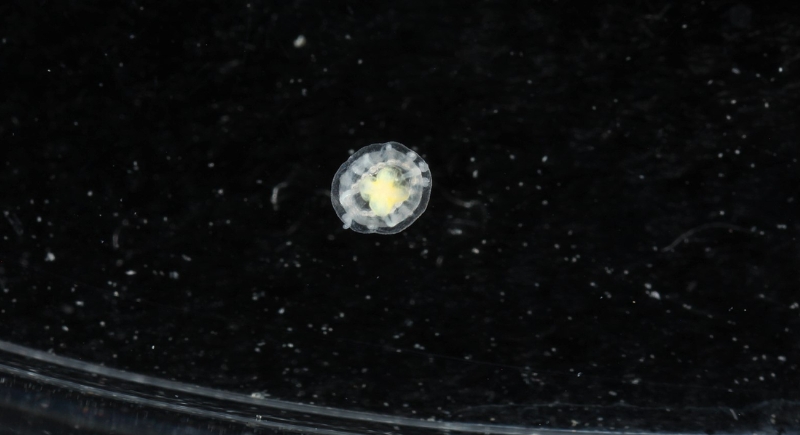The “Immortal Jellyfish” That Can Reverse Its Own Aging Process
In the Mediterranean, researchers have studied a jellyfish that bends the rules of aging. The jellyfish is called Turritopsis dohrnii. It is no bigger than a fingernail, yet it can revert from its adult form back to a juvenile stage, effectively resetting its life cycle.
This process does not happen once; it can occur again and again under the right conditions. Researchers now study this jellyfish closely because its uncommon cycle may help reveal new insights about lifespan, regeneration, and why some species can reprogram their cells while others cannot.
How the Life Cycle Reverses

Image via Wikimedia Commons/Dr. Karen J. Osborn
Turritopsis dohrnii begins like other jellyfish, with fertilized eggs developing into larvae that settle and grow into polyps. These polyps eventually release small medusae, the free-swimming adult stage most people recognize.
For most animals, adulthood is the final stage of life. Turritopsis dohrnii breaks that rule. Under stress, the jellyfish contracts, sheds its tentacles, and sinks to the seafloor. Within a day or two, it transforms into a cyst that reorganizes into a polyp, essentially starting its life cycle over. This reversal is not the same as the regeneration of a body part, but rather a complete reset into a previous stage of life.
Scientists describe the process as transdifferentiation, where cells transform into different specialized types. Unlike ordinary development, this change runs backward and allows genetically identical medusae to emerge again.
Genetic Clues to Rejuvenation
Genomic research has shown that Turritopsis dohrnii activates more than a thousand genes connected to DNA repair and cellular aging. These genes prioritize stability over rapid growth, which prevents the accumulation of dangerous errors that often occur during regeneration. In humans, damaged DNA frequently drives aging or cancer, but in this jellyfish, the emphasis on repair gives its cells a chance to reset without losing control.
Comparisons between polyps and medusae revealed that cells switch functions as the cycle reverses. Specialized medusa cells reprogram themselves to behave like polyp cells, essentially turning the biological clock backward. This control makes this creature unique, since no other known animal can revert to a pre-adult stage after reaching maturity.
Understanding which genetic switches allow such precision could someday guide researchers studying aging-related diseases, though translating these findings into human biology remains a challenge because our DNA damage responses differ significantly from those of the jellyfish.
Studying Them in the Laboratory

Image via Canva/Aflo Images
Caring for immortal jellyfish outside the ocean requires significant patience. Japanese scientist Shin Kubota has maintained colonies in captivity since the 1990s, while documenting their ability to rejuvenate repeatedly. His studies showed that individual jellyfish could loop back into polyps up to ten times within two years, sometimes within just a month of reaching adulthood.
However, keeping them alive involves daily monitoring and extremely precise feeding. Kubota must slice brine shrimp eggs under a microscope so they are small enough for the jellyfish to consume. Even with such attention, colonies remain delicate and easily lost, which limits large-scale experiments.
Still, Kubota’s persistence has provided rare glimpses into how transdifferentiation works in practice. His work demonstrated that the life cycle reversal is not theoretical but happens in real populations under controlled conditions. These experiments, though time-consuming, remain one of the best resources for scientists trying to understand how an animal can reverse cellular decline in such a way.